Community Health Assessment: Diabetes among South Asian Immigrants
VerifiedAdded on 2022/09/12
|12
|2964
|15
Report
AI Summary
This report presents a community-based health assessment focusing on the development of diabetes among South Asian immigrants residing in Toronto, Canada. Utilizing the Population Health Promotion Model, the assessment examines the population's demographics, social environments (income and social status), education/work statistics, social support networks, and health practices. The study highlights the prevalence of type 2 diabetes among this population, attributing it to factors such as poor financial status, limited access to healthcare, and gender discrimination within the community. The report analyzes key social determinants of health, including income, healthcare access, and gender dynamics, to identify the root causes of health disparities. The assessment concludes with a community diagnosis emphasizing the need for interventions to address these challenges and promote health equity. The report also emphasizes the importance of community-based healthcare setups, transportation, and the expensive healthcare system as factors that contribute to the increase in diabetes risk. This assessment aims to provide a framework for public health agencies to identify and address the health needs of this specific population.
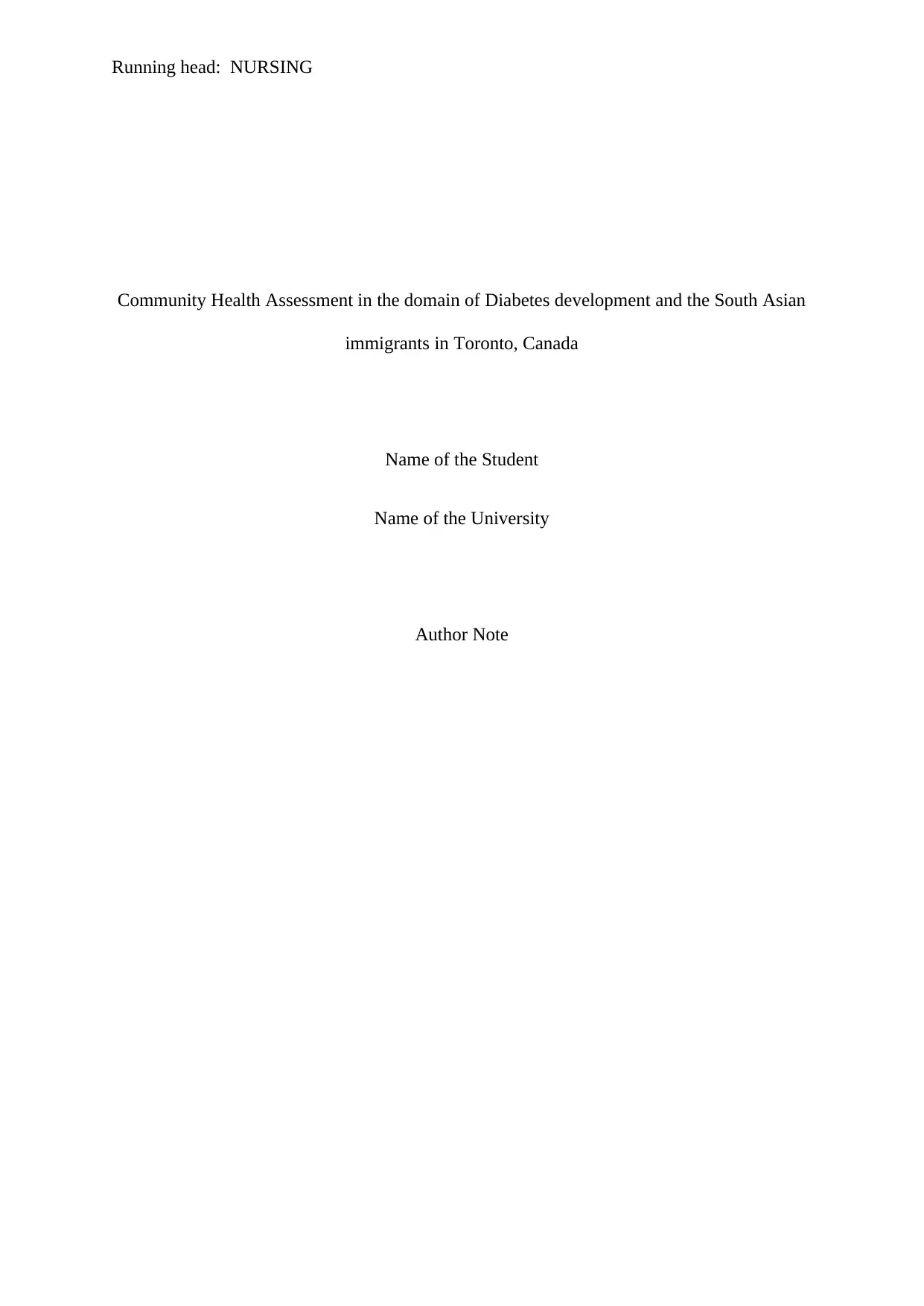
Running head: NURSING
Community Health Assessment in the domain of Diabetes development and the South Asian
immigrants in Toronto, Canada
Name of the Student
Name of the University
Author Note
Community Health Assessment in the domain of Diabetes development and the South Asian
immigrants in Toronto, Canada
Name of the Student
Name of the University
Author Note
Paraphrase This Document
Need a fresh take? Get an instant paraphrase of this document with our AI Paraphraser
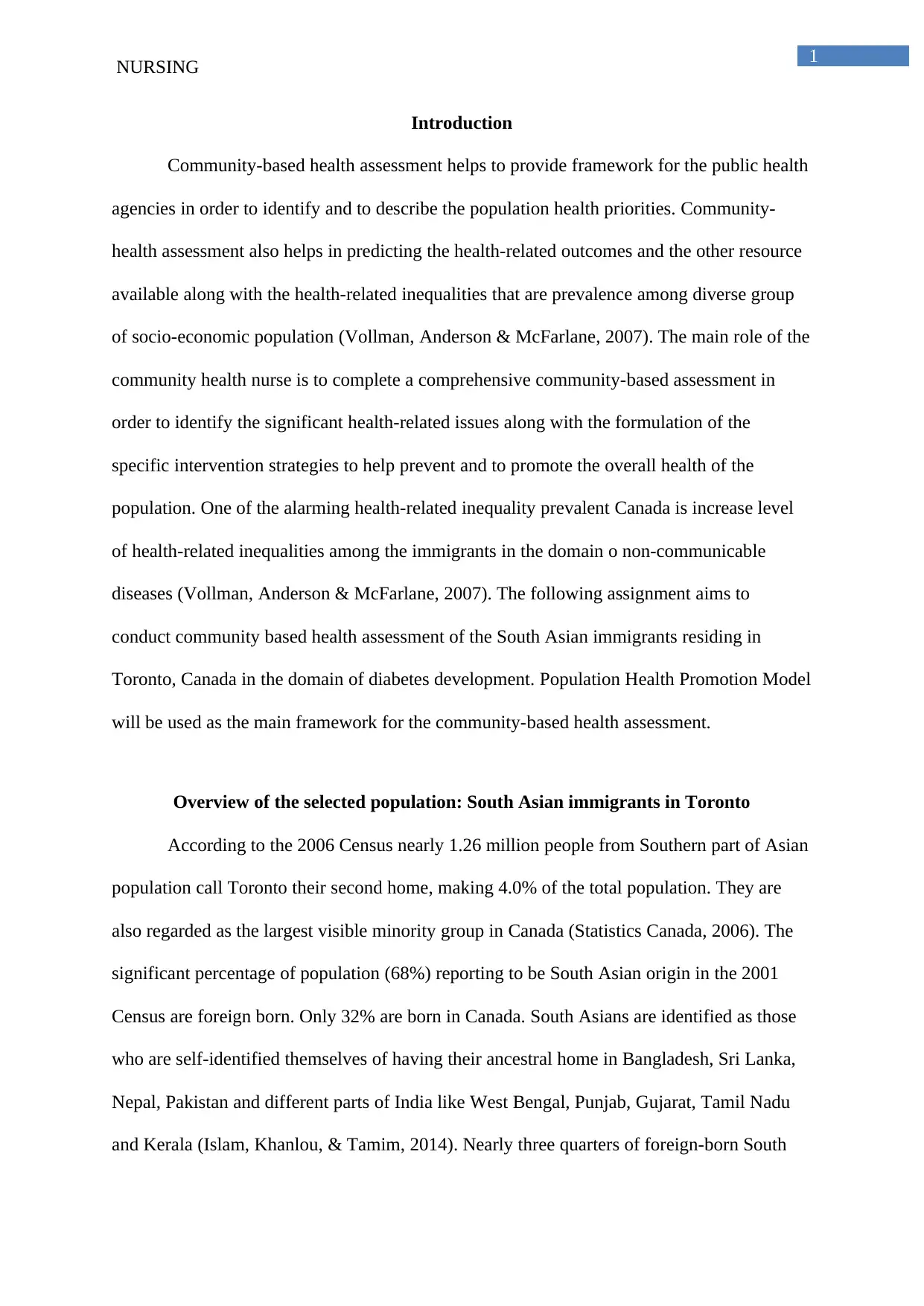
1
NURSING
Introduction
Community-based health assessment helps to provide framework for the public health
agencies in order to identify and to describe the population health priorities. Community-
health assessment also helps in predicting the health-related outcomes and the other resource
available along with the health-related inequalities that are prevalence among diverse group
of socio-economic population (Vollman, Anderson & McFarlane, 2007). The main role of the
community health nurse is to complete a comprehensive community-based assessment in
order to identify the significant health-related issues along with the formulation of the
specific intervention strategies to help prevent and to promote the overall health of the
population. One of the alarming health-related inequality prevalent Canada is increase level
of health-related inequalities among the immigrants in the domain o non-communicable
diseases (Vollman, Anderson & McFarlane, 2007). The following assignment aims to
conduct community based health assessment of the South Asian immigrants residing in
Toronto, Canada in the domain of diabetes development. Population Health Promotion Model
will be used as the main framework for the community-based health assessment.
Overview of the selected population: South Asian immigrants in Toronto
According to the 2006 Census nearly 1.26 million people from Southern part of Asian
population call Toronto their second home, making 4.0% of the total population. They are
also regarded as the largest visible minority group in Canada (Statistics Canada, 2006). The
significant percentage of population (68%) reporting to be South Asian origin in the 2001
Census are foreign born. Only 32% are born in Canada. South Asians are identified as those
who are self-identified themselves of having their ancestral home in Bangladesh, Sri Lanka,
Nepal, Pakistan and different parts of India like West Bengal, Punjab, Gujarat, Tamil Nadu
and Kerala (Islam, Khanlou, & Tamim, 2014). Nearly three quarters of foreign-born South
NURSING
Introduction
Community-based health assessment helps to provide framework for the public health
agencies in order to identify and to describe the population health priorities. Community-
health assessment also helps in predicting the health-related outcomes and the other resource
available along with the health-related inequalities that are prevalence among diverse group
of socio-economic population (Vollman, Anderson & McFarlane, 2007). The main role of the
community health nurse is to complete a comprehensive community-based assessment in
order to identify the significant health-related issues along with the formulation of the
specific intervention strategies to help prevent and to promote the overall health of the
population. One of the alarming health-related inequality prevalent Canada is increase level
of health-related inequalities among the immigrants in the domain o non-communicable
diseases (Vollman, Anderson & McFarlane, 2007). The following assignment aims to
conduct community based health assessment of the South Asian immigrants residing in
Toronto, Canada in the domain of diabetes development. Population Health Promotion Model
will be used as the main framework for the community-based health assessment.
Overview of the selected population: South Asian immigrants in Toronto
According to the 2006 Census nearly 1.26 million people from Southern part of Asian
population call Toronto their second home, making 4.0% of the total population. They are
also regarded as the largest visible minority group in Canada (Statistics Canada, 2006). The
significant percentage of population (68%) reporting to be South Asian origin in the 2001
Census are foreign born. Only 32% are born in Canada. South Asians are identified as those
who are self-identified themselves of having their ancestral home in Bangladesh, Sri Lanka,
Nepal, Pakistan and different parts of India like West Bengal, Punjab, Gujarat, Tamil Nadu
and Kerala (Islam, Khanlou, & Tamim, 2014). Nearly three quarters of foreign-born South
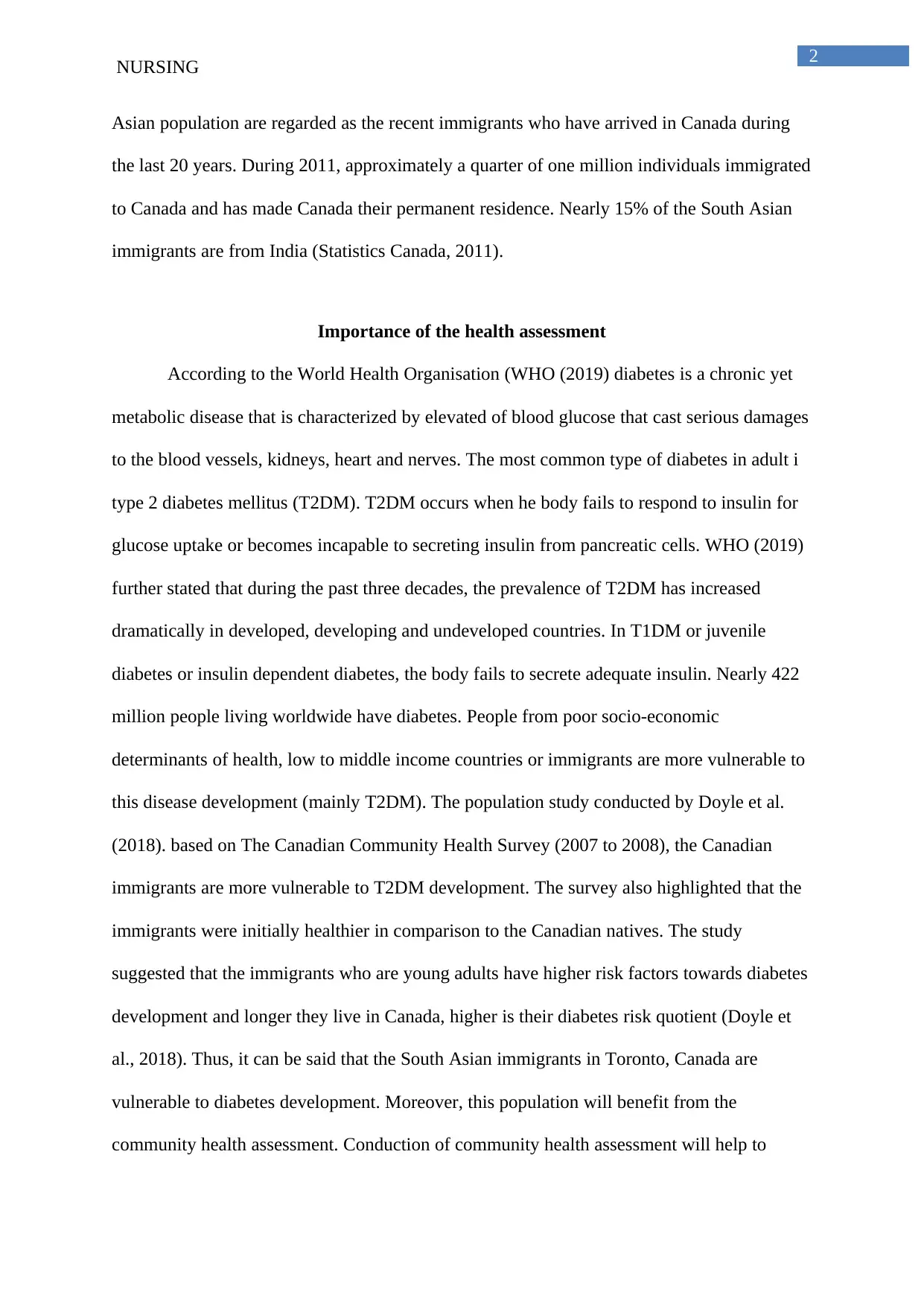
2
NURSING
Asian population are regarded as the recent immigrants who have arrived in Canada during
the last 20 years. During 2011, approximately a quarter of one million individuals immigrated
to Canada and has made Canada their permanent residence. Nearly 15% of the South Asian
immigrants are from India (Statistics Canada, 2011).
Importance of the health assessment
According to the World Health Organisation (WHO (2019) diabetes is a chronic yet
metabolic disease that is characterized by elevated of blood glucose that cast serious damages
to the blood vessels, kidneys, heart and nerves. The most common type of diabetes in adult i
type 2 diabetes mellitus (T2DM). T2DM occurs when he body fails to respond to insulin for
glucose uptake or becomes incapable to secreting insulin from pancreatic cells. WHO (2019)
further stated that during the past three decades, the prevalence of T2DM has increased
dramatically in developed, developing and undeveloped countries. In T1DM or juvenile
diabetes or insulin dependent diabetes, the body fails to secrete adequate insulin. Nearly 422
million people living worldwide have diabetes. People from poor socio-economic
determinants of health, low to middle income countries or immigrants are more vulnerable to
this disease development (mainly T2DM). The population study conducted by Doyle et al.
(2018). based on The Canadian Community Health Survey (2007 to 2008), the Canadian
immigrants are more vulnerable to T2DM development. The survey also highlighted that the
immigrants were initially healthier in comparison to the Canadian natives. The study
suggested that the immigrants who are young adults have higher risk factors towards diabetes
development and longer they live in Canada, higher is their diabetes risk quotient (Doyle et
al., 2018). Thus, it can be said that the South Asian immigrants in Toronto, Canada are
vulnerable to diabetes development. Moreover, this population will benefit from the
community health assessment. Conduction of community health assessment will help to
NURSING
Asian population are regarded as the recent immigrants who have arrived in Canada during
the last 20 years. During 2011, approximately a quarter of one million individuals immigrated
to Canada and has made Canada their permanent residence. Nearly 15% of the South Asian
immigrants are from India (Statistics Canada, 2011).
Importance of the health assessment
According to the World Health Organisation (WHO (2019) diabetes is a chronic yet
metabolic disease that is characterized by elevated of blood glucose that cast serious damages
to the blood vessels, kidneys, heart and nerves. The most common type of diabetes in adult i
type 2 diabetes mellitus (T2DM). T2DM occurs when he body fails to respond to insulin for
glucose uptake or becomes incapable to secreting insulin from pancreatic cells. WHO (2019)
further stated that during the past three decades, the prevalence of T2DM has increased
dramatically in developed, developing and undeveloped countries. In T1DM or juvenile
diabetes or insulin dependent diabetes, the body fails to secrete adequate insulin. Nearly 422
million people living worldwide have diabetes. People from poor socio-economic
determinants of health, low to middle income countries or immigrants are more vulnerable to
this disease development (mainly T2DM). The population study conducted by Doyle et al.
(2018). based on The Canadian Community Health Survey (2007 to 2008), the Canadian
immigrants are more vulnerable to T2DM development. The survey also highlighted that the
immigrants were initially healthier in comparison to the Canadian natives. The study
suggested that the immigrants who are young adults have higher risk factors towards diabetes
development and longer they live in Canada, higher is their diabetes risk quotient (Doyle et
al., 2018). Thus, it can be said that the South Asian immigrants in Toronto, Canada are
vulnerable to diabetes development. Moreover, this population will benefit from the
community health assessment. Conduction of community health assessment will help to
⊘ This is a preview!⊘
Do you want full access?
Subscribe today to unlock all pages.

Trusted by 1+ million students worldwide
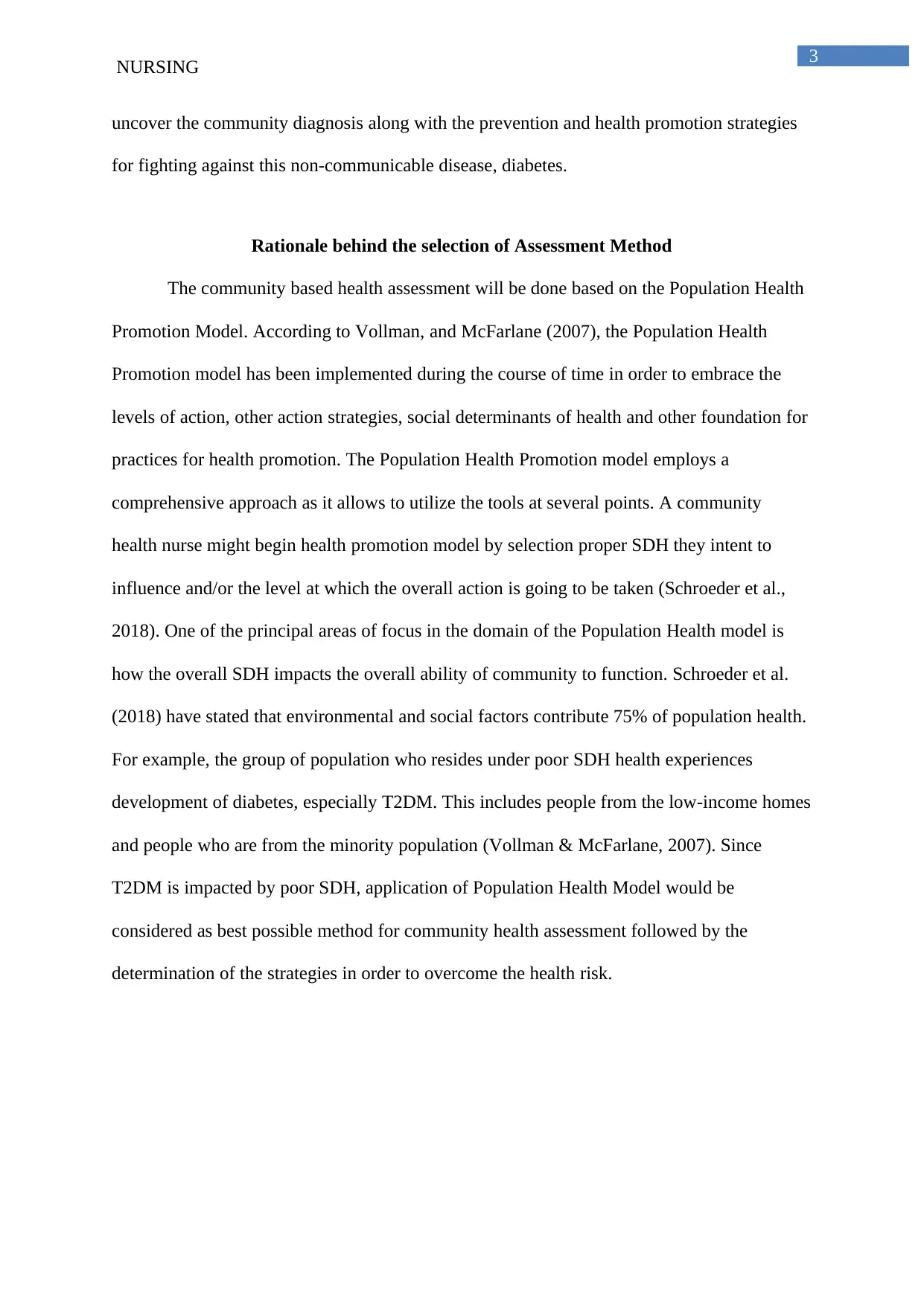
3
NURSING
uncover the community diagnosis along with the prevention and health promotion strategies
for fighting against this non-communicable disease, diabetes.
Rationale behind the selection of Assessment Method
The community based health assessment will be done based on the Population Health
Promotion Model. According to Vollman, and McFarlane (2007), the Population Health
Promotion model has been implemented during the course of time in order to embrace the
levels of action, other action strategies, social determinants of health and other foundation for
practices for health promotion. The Population Health Promotion model employs a
comprehensive approach as it allows to utilize the tools at several points. A community
health nurse might begin health promotion model by selection proper SDH they intent to
influence and/or the level at which the overall action is going to be taken (Schroeder et al.,
2018). One of the principal areas of focus in the domain of the Population Health model is
how the overall SDH impacts the overall ability of community to function. Schroeder et al.
(2018) have stated that environmental and social factors contribute 75% of population health.
For example, the group of population who resides under poor SDH health experiences
development of diabetes, especially T2DM. This includes people from the low-income homes
and people who are from the minority population (Vollman & McFarlane, 2007). Since
T2DM is impacted by poor SDH, application of Population Health Model would be
considered as best possible method for community health assessment followed by the
determination of the strategies in order to overcome the health risk.
NURSING
uncover the community diagnosis along with the prevention and health promotion strategies
for fighting against this non-communicable disease, diabetes.
Rationale behind the selection of Assessment Method
The community based health assessment will be done based on the Population Health
Promotion Model. According to Vollman, and McFarlane (2007), the Population Health
Promotion model has been implemented during the course of time in order to embrace the
levels of action, other action strategies, social determinants of health and other foundation for
practices for health promotion. The Population Health Promotion model employs a
comprehensive approach as it allows to utilize the tools at several points. A community
health nurse might begin health promotion model by selection proper SDH they intent to
influence and/or the level at which the overall action is going to be taken (Schroeder et al.,
2018). One of the principal areas of focus in the domain of the Population Health model is
how the overall SDH impacts the overall ability of community to function. Schroeder et al.
(2018) have stated that environmental and social factors contribute 75% of population health.
For example, the group of population who resides under poor SDH health experiences
development of diabetes, especially T2DM. This includes people from the low-income homes
and people who are from the minority population (Vollman & McFarlane, 2007). Since
T2DM is impacted by poor SDH, application of Population Health Model would be
considered as best possible method for community health assessment followed by the
determination of the strategies in order to overcome the health risk.
Paraphrase This Document
Need a fresh take? Get an instant paraphrase of this document with our AI Paraphraser
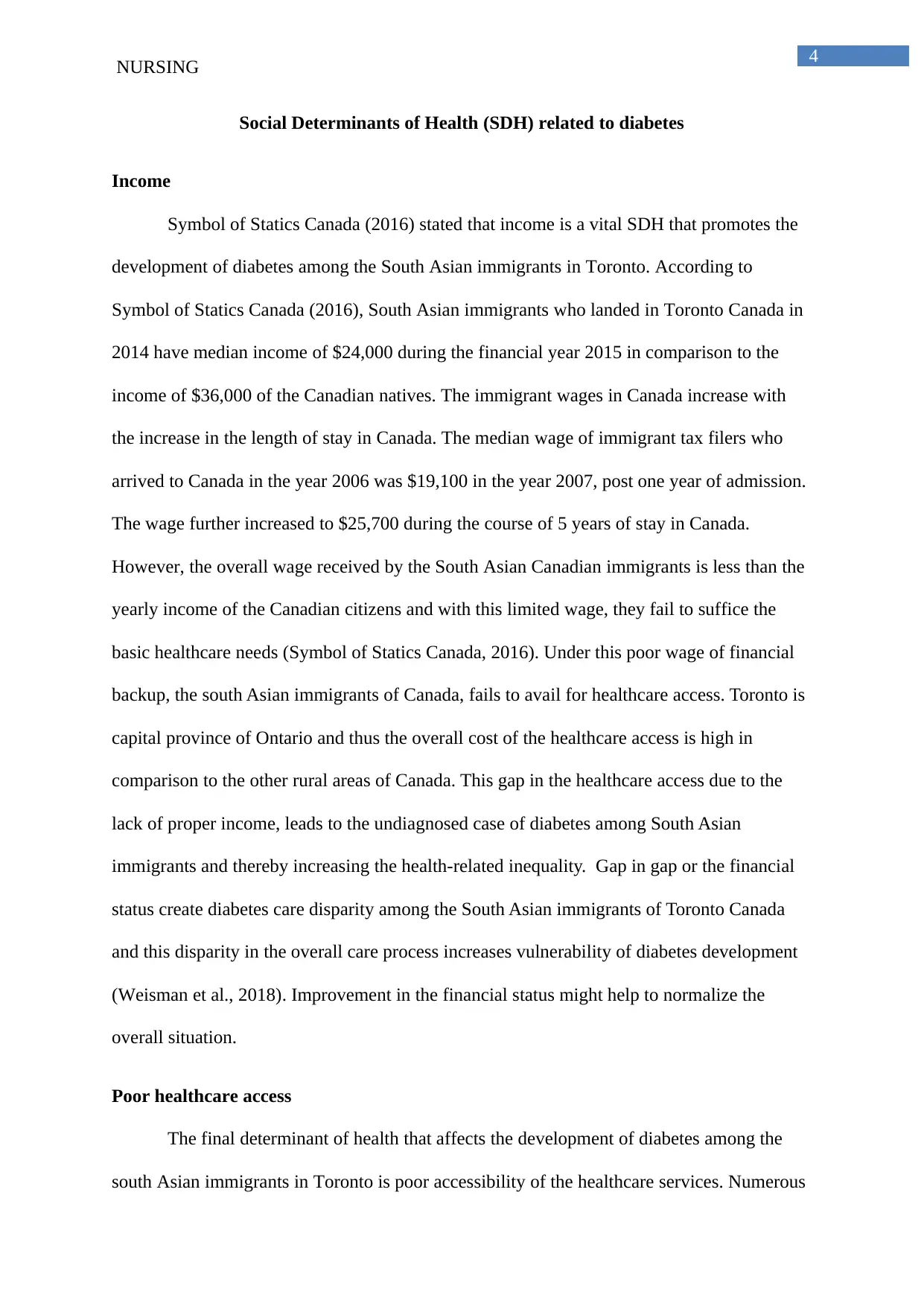
4
NURSING
Social Determinants of Health (SDH) related to diabetes
Income
Symbol of Statics Canada (2016) stated that income is a vital SDH that promotes the
development of diabetes among the South Asian immigrants in Toronto. According to
Symbol of Statics Canada (2016), South Asian immigrants who landed in Toronto Canada in
2014 have median income of $24,000 during the financial year 2015 in comparison to the
income of $36,000 of the Canadian natives. The immigrant wages in Canada increase with
the increase in the length of stay in Canada. The median wage of immigrant tax filers who
arrived to Canada in the year 2006 was $19,100 in the year 2007, post one year of admission.
The wage further increased to $25,700 during the course of 5 years of stay in Canada.
However, the overall wage received by the South Asian Canadian immigrants is less than the
yearly income of the Canadian citizens and with this limited wage, they fail to suffice the
basic healthcare needs (Symbol of Statics Canada, 2016). Under this poor wage of financial
backup, the south Asian immigrants of Canada, fails to avail for healthcare access. Toronto is
capital province of Ontario and thus the overall cost of the healthcare access is high in
comparison to the other rural areas of Canada. This gap in the healthcare access due to the
lack of proper income, leads to the undiagnosed case of diabetes among South Asian
immigrants and thereby increasing the health-related inequality. Gap in gap or the financial
status create diabetes care disparity among the South Asian immigrants of Toronto Canada
and this disparity in the overall care process increases vulnerability of diabetes development
(Weisman et al., 2018). Improvement in the financial status might help to normalize the
overall situation.
Poor healthcare access
The final determinant of health that affects the development of diabetes among the
south Asian immigrants in Toronto is poor accessibility of the healthcare services. Numerous
NURSING
Social Determinants of Health (SDH) related to diabetes
Income
Symbol of Statics Canada (2016) stated that income is a vital SDH that promotes the
development of diabetes among the South Asian immigrants in Toronto. According to
Symbol of Statics Canada (2016), South Asian immigrants who landed in Toronto Canada in
2014 have median income of $24,000 during the financial year 2015 in comparison to the
income of $36,000 of the Canadian natives. The immigrant wages in Canada increase with
the increase in the length of stay in Canada. The median wage of immigrant tax filers who
arrived to Canada in the year 2006 was $19,100 in the year 2007, post one year of admission.
The wage further increased to $25,700 during the course of 5 years of stay in Canada.
However, the overall wage received by the South Asian Canadian immigrants is less than the
yearly income of the Canadian citizens and with this limited wage, they fail to suffice the
basic healthcare needs (Symbol of Statics Canada, 2016). Under this poor wage of financial
backup, the south Asian immigrants of Canada, fails to avail for healthcare access. Toronto is
capital province of Ontario and thus the overall cost of the healthcare access is high in
comparison to the other rural areas of Canada. This gap in the healthcare access due to the
lack of proper income, leads to the undiagnosed case of diabetes among South Asian
immigrants and thereby increasing the health-related inequality. Gap in gap or the financial
status create diabetes care disparity among the South Asian immigrants of Toronto Canada
and this disparity in the overall care process increases vulnerability of diabetes development
(Weisman et al., 2018). Improvement in the financial status might help to normalize the
overall situation.
Poor healthcare access
The final determinant of health that affects the development of diabetes among the
south Asian immigrants in Toronto is poor accessibility of the healthcare services. Numerous
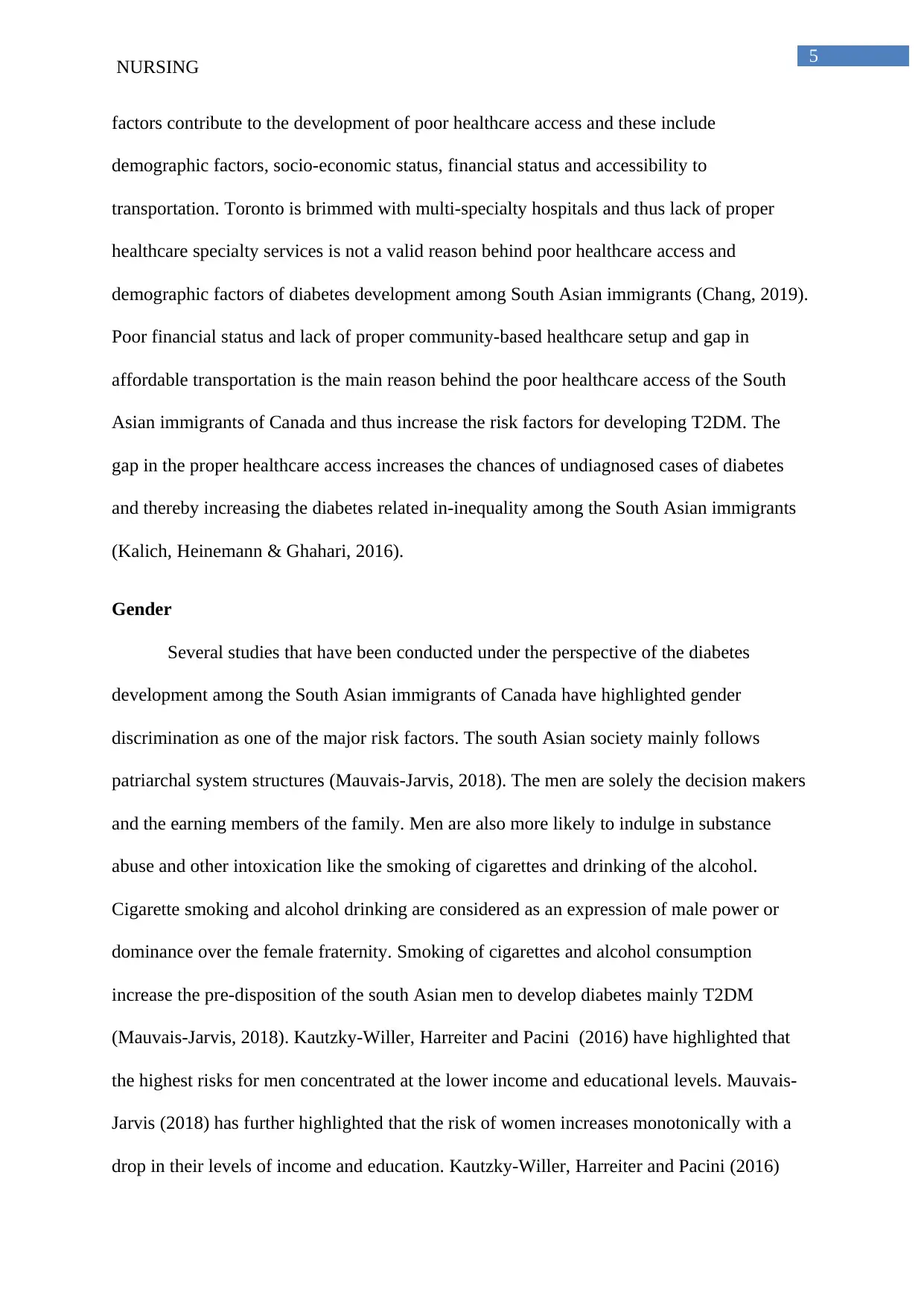
5
NURSING
factors contribute to the development of poor healthcare access and these include
demographic factors, socio-economic status, financial status and accessibility to
transportation. Toronto is brimmed with multi-specialty hospitals and thus lack of proper
healthcare specialty services is not a valid reason behind poor healthcare access and
demographic factors of diabetes development among South Asian immigrants (Chang, 2019).
Poor financial status and lack of proper community-based healthcare setup and gap in
affordable transportation is the main reason behind the poor healthcare access of the South
Asian immigrants of Canada and thus increase the risk factors for developing T2DM. The
gap in the proper healthcare access increases the chances of undiagnosed cases of diabetes
and thereby increasing the diabetes related in-inequality among the South Asian immigrants
(Kalich, Heinemann & Ghahari, 2016).
Gender
Several studies that have been conducted under the perspective of the diabetes
development among the South Asian immigrants of Canada have highlighted gender
discrimination as one of the major risk factors. The south Asian society mainly follows
patriarchal system structures (Mauvais-Jarvis, 2018). The men are solely the decision makers
and the earning members of the family. Men are also more likely to indulge in substance
abuse and other intoxication like the smoking of cigarettes and drinking of the alcohol.
Cigarette smoking and alcohol drinking are considered as an expression of male power or
dominance over the female fraternity. Smoking of cigarettes and alcohol consumption
increase the pre-disposition of the south Asian men to develop diabetes mainly T2DM
(Mauvais-Jarvis, 2018). Kautzky-Willer, Harreiter and Pacini (2016) have highlighted that
the highest risks for men concentrated at the lower income and educational levels. Mauvais-
Jarvis (2018) has further highlighted that the risk of women increases monotonically with a
drop in their levels of income and education. Kautzky-Willer, Harreiter and Pacini (2016)
NURSING
factors contribute to the development of poor healthcare access and these include
demographic factors, socio-economic status, financial status and accessibility to
transportation. Toronto is brimmed with multi-specialty hospitals and thus lack of proper
healthcare specialty services is not a valid reason behind poor healthcare access and
demographic factors of diabetes development among South Asian immigrants (Chang, 2019).
Poor financial status and lack of proper community-based healthcare setup and gap in
affordable transportation is the main reason behind the poor healthcare access of the South
Asian immigrants of Canada and thus increase the risk factors for developing T2DM. The
gap in the proper healthcare access increases the chances of undiagnosed cases of diabetes
and thereby increasing the diabetes related in-inequality among the South Asian immigrants
(Kalich, Heinemann & Ghahari, 2016).
Gender
Several studies that have been conducted under the perspective of the diabetes
development among the South Asian immigrants of Canada have highlighted gender
discrimination as one of the major risk factors. The south Asian society mainly follows
patriarchal system structures (Mauvais-Jarvis, 2018). The men are solely the decision makers
and the earning members of the family. Men are also more likely to indulge in substance
abuse and other intoxication like the smoking of cigarettes and drinking of the alcohol.
Cigarette smoking and alcohol drinking are considered as an expression of male power or
dominance over the female fraternity. Smoking of cigarettes and alcohol consumption
increase the pre-disposition of the south Asian men to develop diabetes mainly T2DM
(Mauvais-Jarvis, 2018). Kautzky-Willer, Harreiter and Pacini (2016) have highlighted that
the highest risks for men concentrated at the lower income and educational levels. Mauvais-
Jarvis (2018) has further highlighted that the risk of women increases monotonically with a
drop in their levels of income and education. Kautzky-Willer, Harreiter and Pacini (2016)
⊘ This is a preview!⊘
Do you want full access?
Subscribe today to unlock all pages.

Trusted by 1+ million students worldwide
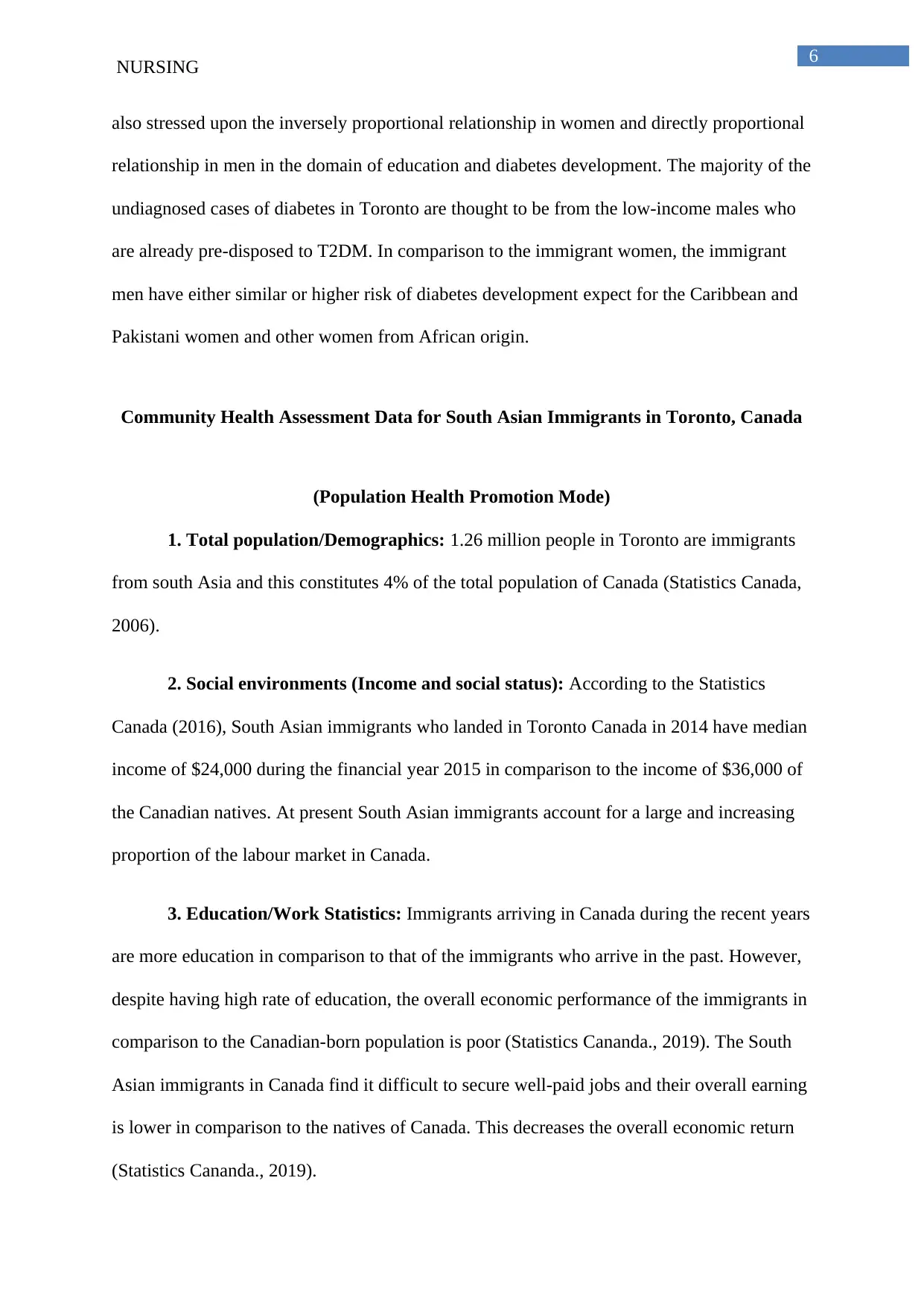
6
NURSING
also stressed upon the inversely proportional relationship in women and directly proportional
relationship in men in the domain of education and diabetes development. The majority of the
undiagnosed cases of diabetes in Toronto are thought to be from the low-income males who
are already pre-disposed to T2DM. In comparison to the immigrant women, the immigrant
men have either similar or higher risk of diabetes development expect for the Caribbean and
Pakistani women and other women from African origin.
Community Health Assessment Data for South Asian Immigrants in Toronto, Canada
(Population Health Promotion Mode)
1. Total population/Demographics: 1.26 million people in Toronto are immigrants
from south Asia and this constitutes 4% of the total population of Canada (Statistics Canada,
2006).
2. Social environments (Income and social status): According to the Statistics
Canada (2016), South Asian immigrants who landed in Toronto Canada in 2014 have median
income of $24,000 during the financial year 2015 in comparison to the income of $36,000 of
the Canadian natives. At present South Asian immigrants account for a large and increasing
proportion of the labour market in Canada.
3. Education/Work Statistics: Immigrants arriving in Canada during the recent years
are more education in comparison to that of the immigrants who arrive in the past. However,
despite having high rate of education, the overall economic performance of the immigrants in
comparison to the Canadian-born population is poor (Statistics Cananda., 2019). The South
Asian immigrants in Canada find it difficult to secure well-paid jobs and their overall earning
is lower in comparison to the natives of Canada. This decreases the overall economic return
(Statistics Cananda., 2019).
NURSING
also stressed upon the inversely proportional relationship in women and directly proportional
relationship in men in the domain of education and diabetes development. The majority of the
undiagnosed cases of diabetes in Toronto are thought to be from the low-income males who
are already pre-disposed to T2DM. In comparison to the immigrant women, the immigrant
men have either similar or higher risk of diabetes development expect for the Caribbean and
Pakistani women and other women from African origin.
Community Health Assessment Data for South Asian Immigrants in Toronto, Canada
(Population Health Promotion Mode)
1. Total population/Demographics: 1.26 million people in Toronto are immigrants
from south Asia and this constitutes 4% of the total population of Canada (Statistics Canada,
2006).
2. Social environments (Income and social status): According to the Statistics
Canada (2016), South Asian immigrants who landed in Toronto Canada in 2014 have median
income of $24,000 during the financial year 2015 in comparison to the income of $36,000 of
the Canadian natives. At present South Asian immigrants account for a large and increasing
proportion of the labour market in Canada.
3. Education/Work Statistics: Immigrants arriving in Canada during the recent years
are more education in comparison to that of the immigrants who arrive in the past. However,
despite having high rate of education, the overall economic performance of the immigrants in
comparison to the Canadian-born population is poor (Statistics Cananda., 2019). The South
Asian immigrants in Canada find it difficult to secure well-paid jobs and their overall earning
is lower in comparison to the natives of Canada. This decreases the overall economic return
(Statistics Cananda., 2019).
Paraphrase This Document
Need a fresh take? Get an instant paraphrase of this document with our AI Paraphraser
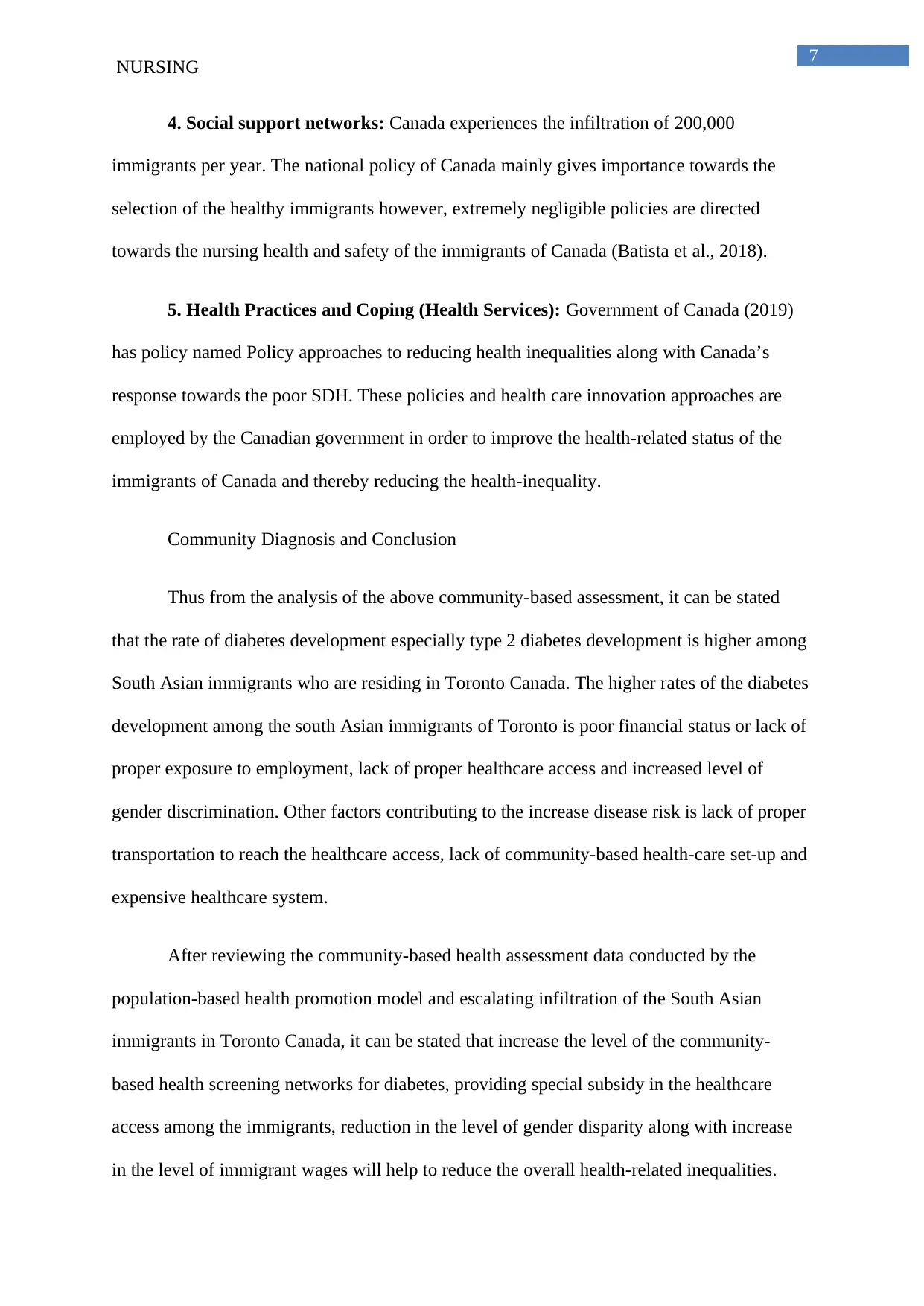
7
NURSING
4. Social support networks: Canada experiences the infiltration of 200,000
immigrants per year. The national policy of Canada mainly gives importance towards the
selection of the healthy immigrants however, extremely negligible policies are directed
towards the nursing health and safety of the immigrants of Canada (Batista et al., 2018).
5. Health Practices and Coping (Health Services): Government of Canada (2019)
has policy named Policy approaches to reducing health inequalities along with Canada’s
response towards the poor SDH. These policies and health care innovation approaches are
employed by the Canadian government in order to improve the health-related status of the
immigrants of Canada and thereby reducing the health-inequality.
Community Diagnosis and Conclusion
Thus from the analysis of the above community-based assessment, it can be stated
that the rate of diabetes development especially type 2 diabetes development is higher among
South Asian immigrants who are residing in Toronto Canada. The higher rates of the diabetes
development among the south Asian immigrants of Toronto is poor financial status or lack of
proper exposure to employment, lack of proper healthcare access and increased level of
gender discrimination. Other factors contributing to the increase disease risk is lack of proper
transportation to reach the healthcare access, lack of community-based health-care set-up and
expensive healthcare system.
After reviewing the community-based health assessment data conducted by the
population-based health promotion model and escalating infiltration of the South Asian
immigrants in Toronto Canada, it can be stated that increase the level of the community-
based health screening networks for diabetes, providing special subsidy in the healthcare
access among the immigrants, reduction in the level of gender disparity along with increase
in the level of immigrant wages will help to reduce the overall health-related inequalities.
NURSING
4. Social support networks: Canada experiences the infiltration of 200,000
immigrants per year. The national policy of Canada mainly gives importance towards the
selection of the healthy immigrants however, extremely negligible policies are directed
towards the nursing health and safety of the immigrants of Canada (Batista et al., 2018).
5. Health Practices and Coping (Health Services): Government of Canada (2019)
has policy named Policy approaches to reducing health inequalities along with Canada’s
response towards the poor SDH. These policies and health care innovation approaches are
employed by the Canadian government in order to improve the health-related status of the
immigrants of Canada and thereby reducing the health-inequality.
Community Diagnosis and Conclusion
Thus from the analysis of the above community-based assessment, it can be stated
that the rate of diabetes development especially type 2 diabetes development is higher among
South Asian immigrants who are residing in Toronto Canada. The higher rates of the diabetes
development among the south Asian immigrants of Toronto is poor financial status or lack of
proper exposure to employment, lack of proper healthcare access and increased level of
gender discrimination. Other factors contributing to the increase disease risk is lack of proper
transportation to reach the healthcare access, lack of community-based health-care set-up and
expensive healthcare system.
After reviewing the community-based health assessment data conducted by the
population-based health promotion model and escalating infiltration of the South Asian
immigrants in Toronto Canada, it can be stated that increase the level of the community-
based health screening networks for diabetes, providing special subsidy in the healthcare
access among the immigrants, reduction in the level of gender disparity along with increase
in the level of immigrant wages will help to reduce the overall health-related inequalities.
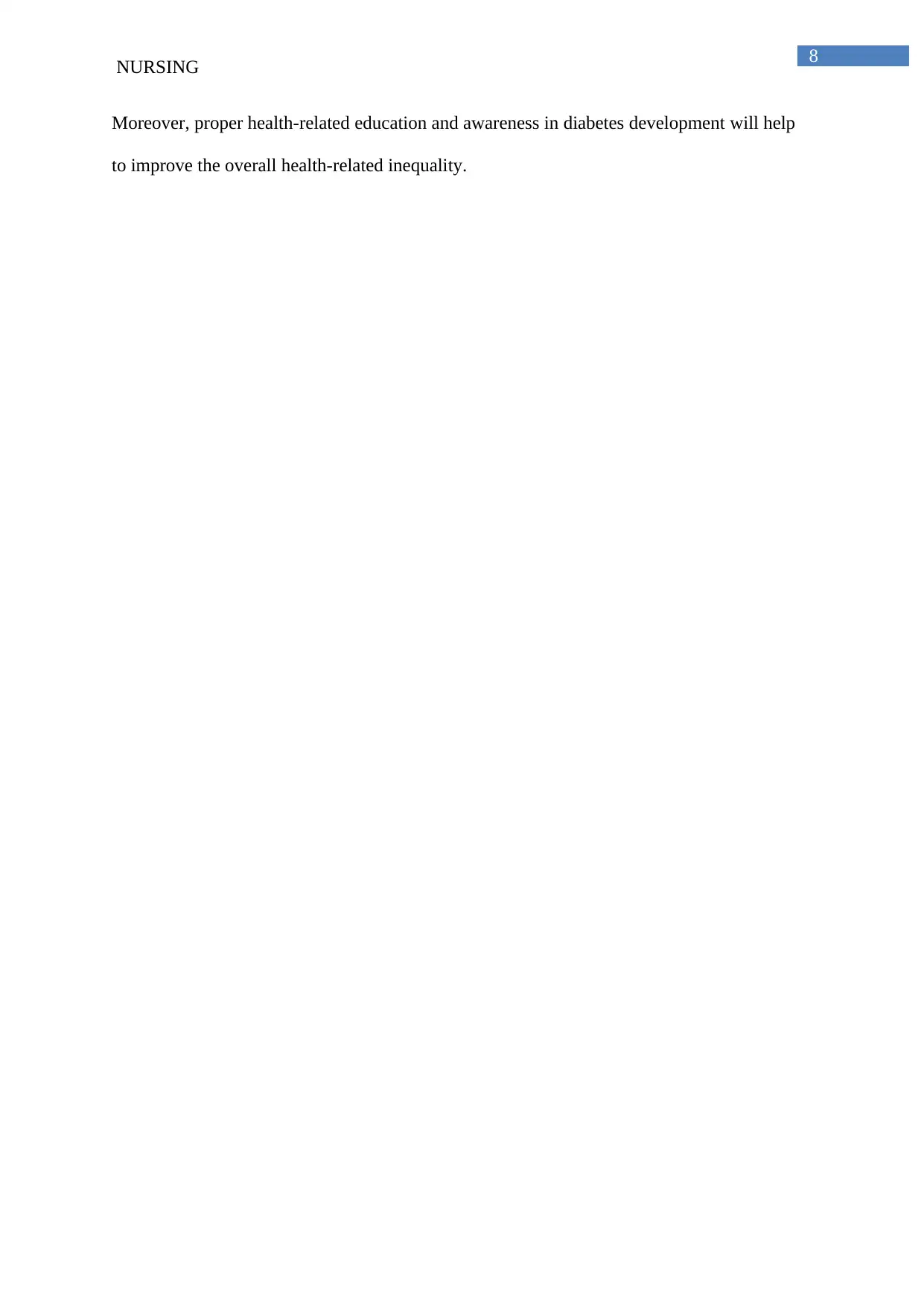
8
NURSING
Moreover, proper health-related education and awareness in diabetes development will help
to improve the overall health-related inequality.
NURSING
Moreover, proper health-related education and awareness in diabetes development will help
to improve the overall health-related inequality.
⊘ This is a preview!⊘
Do you want full access?
Subscribe today to unlock all pages.

Trusted by 1+ million students worldwide
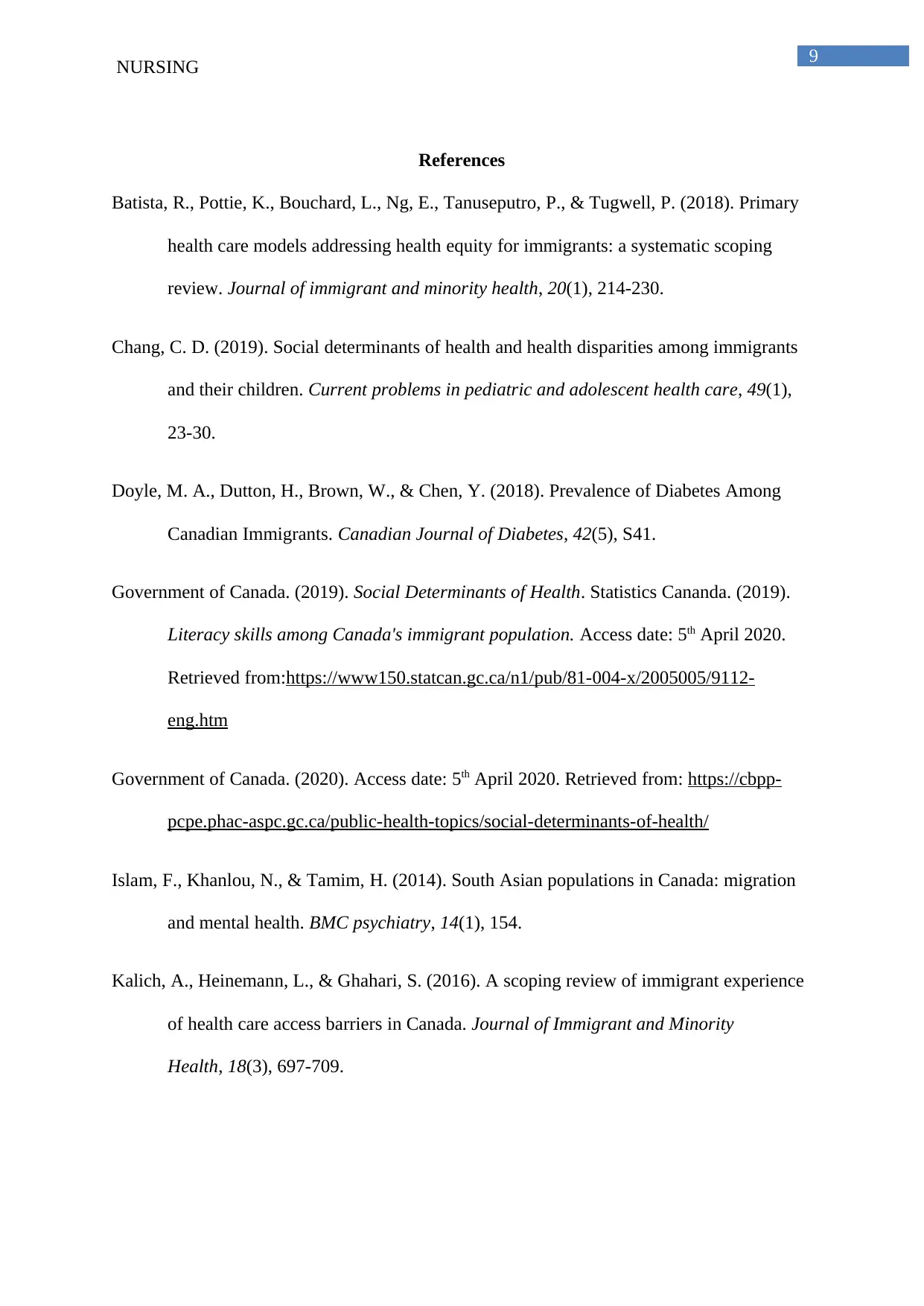
9
NURSING
References
Batista, R., Pottie, K., Bouchard, L., Ng, E., Tanuseputro, P., & Tugwell, P. (2018). Primary
health care models addressing health equity for immigrants: a systematic scoping
review. Journal of immigrant and minority health, 20(1), 214-230.
Chang, C. D. (2019). Social determinants of health and health disparities among immigrants
and their children. Current problems in pediatric and adolescent health care, 49(1),
23-30.
Doyle, M. A., Dutton, H., Brown, W., & Chen, Y. (2018). Prevalence of Diabetes Among
Canadian Immigrants. Canadian Journal of Diabetes, 42(5), S41.
Government of Canada. (2019). Social Determinants of Health. Statistics Cananda. (2019).
Literacy skills among Canada's immigrant population. Access date: 5th April 2020.
Retrieved from:https://www150.statcan.gc.ca/n1/pub/81-004-x/2005005/9112-
eng.htm
Government of Canada. (2020). Access date: 5th April 2020. Retrieved from: https://cbpp-
pcpe.phac-aspc.gc.ca/public-health-topics/social-determinants-of-health/
Islam, F., Khanlou, N., & Tamim, H. (2014). South Asian populations in Canada: migration
and mental health. BMC psychiatry, 14(1), 154.
Kalich, A., Heinemann, L., & Ghahari, S. (2016). A scoping review of immigrant experience
of health care access barriers in Canada. Journal of Immigrant and Minority
Health, 18(3), 697-709.
NURSING
References
Batista, R., Pottie, K., Bouchard, L., Ng, E., Tanuseputro, P., & Tugwell, P. (2018). Primary
health care models addressing health equity for immigrants: a systematic scoping
review. Journal of immigrant and minority health, 20(1), 214-230.
Chang, C. D. (2019). Social determinants of health and health disparities among immigrants
and their children. Current problems in pediatric and adolescent health care, 49(1),
23-30.
Doyle, M. A., Dutton, H., Brown, W., & Chen, Y. (2018). Prevalence of Diabetes Among
Canadian Immigrants. Canadian Journal of Diabetes, 42(5), S41.
Government of Canada. (2019). Social Determinants of Health. Statistics Cananda. (2019).
Literacy skills among Canada's immigrant population. Access date: 5th April 2020.
Retrieved from:https://www150.statcan.gc.ca/n1/pub/81-004-x/2005005/9112-
eng.htm
Government of Canada. (2020). Access date: 5th April 2020. Retrieved from: https://cbpp-
pcpe.phac-aspc.gc.ca/public-health-topics/social-determinants-of-health/
Islam, F., Khanlou, N., & Tamim, H. (2014). South Asian populations in Canada: migration
and mental health. BMC psychiatry, 14(1), 154.
Kalich, A., Heinemann, L., & Ghahari, S. (2016). A scoping review of immigrant experience
of health care access barriers in Canada. Journal of Immigrant and Minority
Health, 18(3), 697-709.
Paraphrase This Document
Need a fresh take? Get an instant paraphrase of this document with our AI Paraphraser
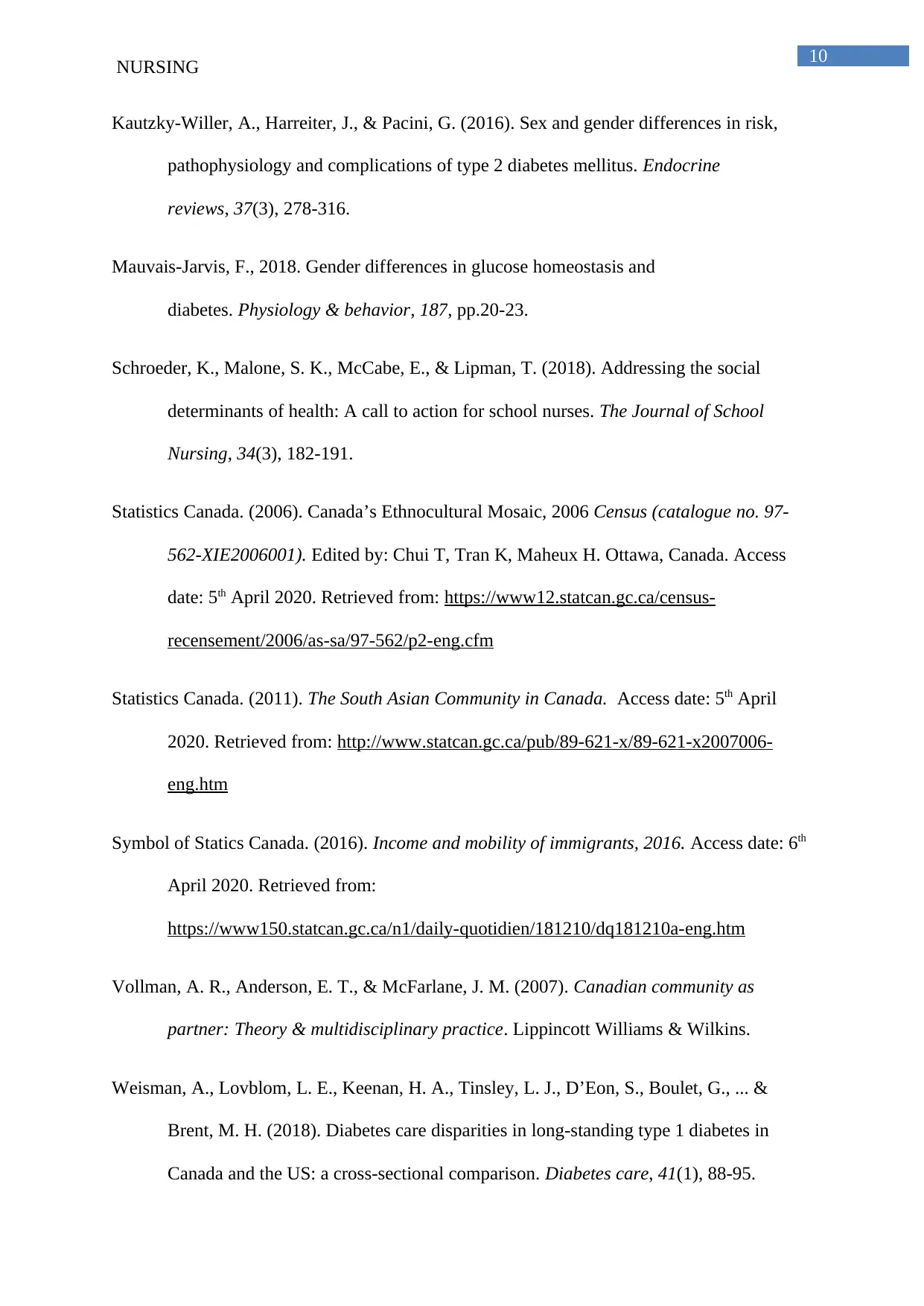
10
NURSING
Kautzky-Willer, A., Harreiter, J., & Pacini, G. (2016). Sex and gender differences in risk,
pathophysiology and complications of type 2 diabetes mellitus. Endocrine
reviews, 37(3), 278-316.
Mauvais-Jarvis, F., 2018. Gender differences in glucose homeostasis and
diabetes. Physiology & behavior, 187, pp.20-23.
Schroeder, K., Malone, S. K., McCabe, E., & Lipman, T. (2018). Addressing the social
determinants of health: A call to action for school nurses. The Journal of School
Nursing, 34(3), 182-191.
Statistics Canada. (2006). Canada’s Ethnocultural Mosaic, 2006 Census (catalogue no. 97-
562-XIE2006001). Edited by: Chui T, Tran K, Maheux H. Ottawa, Canada. Access
date: 5th April 2020. Retrieved from: https://www12.statcan.gc.ca/census-
recensement/2006/as-sa/97-562/p2-eng.cfm
Statistics Canada. (2011). The South Asian Community in Canada. Access date: 5th April
2020. Retrieved from: http://www.statcan.gc.ca/pub/89-621-x/89-621-x2007006-
eng.htm
Symbol of Statics Canada. (2016). Income and mobility of immigrants, 2016. Access date: 6th
April 2020. Retrieved from:
https://www150.statcan.gc.ca/n1/daily-quotidien/181210/dq181210a-eng.htm
Vollman, A. R., Anderson, E. T., & McFarlane, J. M. (2007). Canadian community as
partner: Theory & multidisciplinary practice. Lippincott Williams & Wilkins.
Weisman, A., Lovblom, L. E., Keenan, H. A., Tinsley, L. J., D’Eon, S., Boulet, G., ... &
Brent, M. H. (2018). Diabetes care disparities in long-standing type 1 diabetes in
Canada and the US: a cross-sectional comparison. Diabetes care, 41(1), 88-95.
NURSING
Kautzky-Willer, A., Harreiter, J., & Pacini, G. (2016). Sex and gender differences in risk,
pathophysiology and complications of type 2 diabetes mellitus. Endocrine
reviews, 37(3), 278-316.
Mauvais-Jarvis, F., 2018. Gender differences in glucose homeostasis and
diabetes. Physiology & behavior, 187, pp.20-23.
Schroeder, K., Malone, S. K., McCabe, E., & Lipman, T. (2018). Addressing the social
determinants of health: A call to action for school nurses. The Journal of School
Nursing, 34(3), 182-191.
Statistics Canada. (2006). Canada’s Ethnocultural Mosaic, 2006 Census (catalogue no. 97-
562-XIE2006001). Edited by: Chui T, Tran K, Maheux H. Ottawa, Canada. Access
date: 5th April 2020. Retrieved from: https://www12.statcan.gc.ca/census-
recensement/2006/as-sa/97-562/p2-eng.cfm
Statistics Canada. (2011). The South Asian Community in Canada. Access date: 5th April
2020. Retrieved from: http://www.statcan.gc.ca/pub/89-621-x/89-621-x2007006-
eng.htm
Symbol of Statics Canada. (2016). Income and mobility of immigrants, 2016. Access date: 6th
April 2020. Retrieved from:
https://www150.statcan.gc.ca/n1/daily-quotidien/181210/dq181210a-eng.htm
Vollman, A. R., Anderson, E. T., & McFarlane, J. M. (2007). Canadian community as
partner: Theory & multidisciplinary practice. Lippincott Williams & Wilkins.
Weisman, A., Lovblom, L. E., Keenan, H. A., Tinsley, L. J., D’Eon, S., Boulet, G., ... &
Brent, M. H. (2018). Diabetes care disparities in long-standing type 1 diabetes in
Canada and the US: a cross-sectional comparison. Diabetes care, 41(1), 88-95.
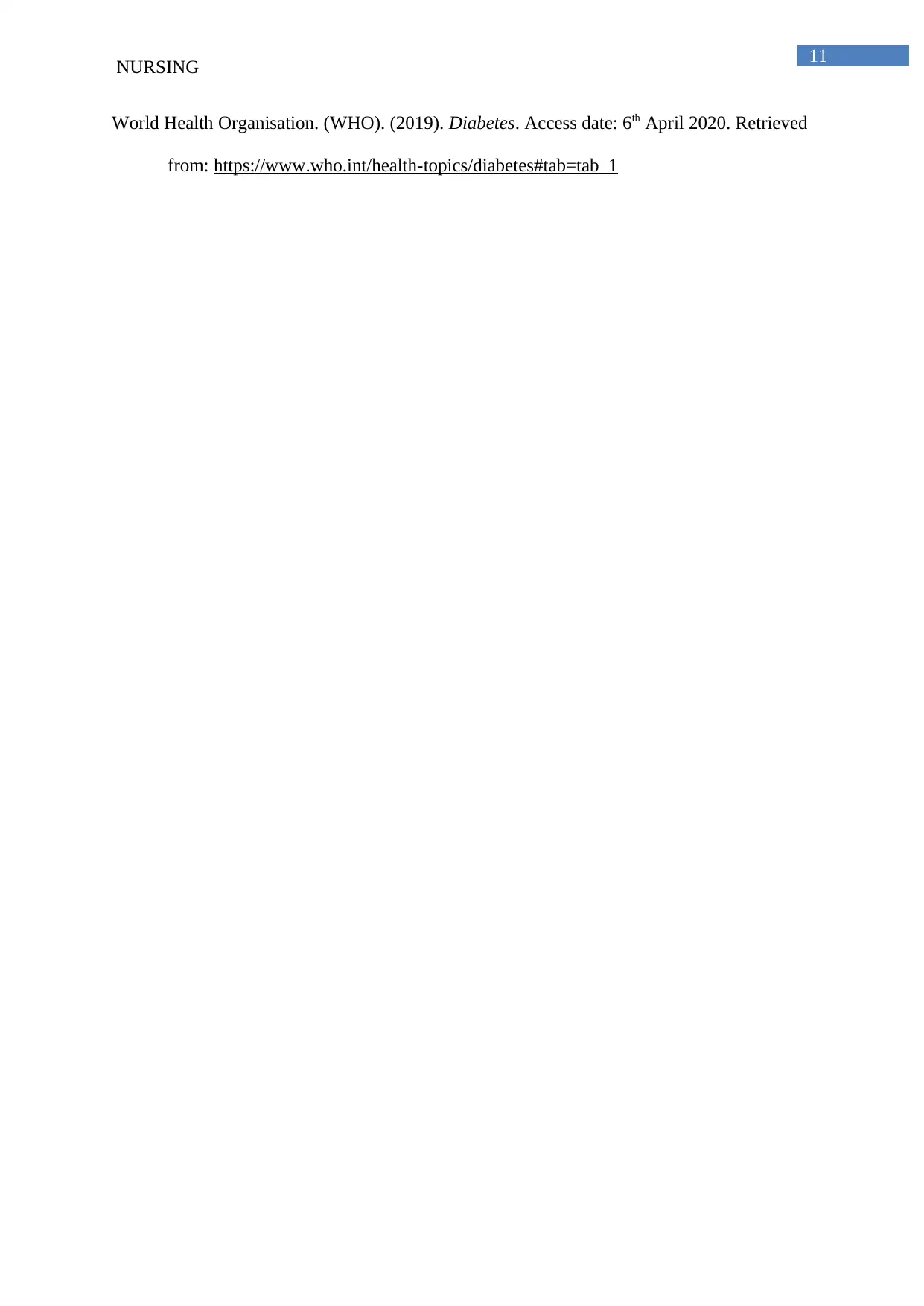
11
NURSING
World Health Organisation. (WHO). (2019). Diabetes. Access date: 6th April 2020. Retrieved
from: https://www.who.int/health-topics/diabetes#tab=tab_1
NURSING
World Health Organisation. (WHO). (2019). Diabetes. Access date: 6th April 2020. Retrieved
from: https://www.who.int/health-topics/diabetes#tab=tab_1
⊘ This is a preview!⊘
Do you want full access?
Subscribe today to unlock all pages.

Trusted by 1+ million students worldwide
1 out of 12
Your All-in-One AI-Powered Toolkit for Academic Success.
+13062052269
info@desklib.com
Available 24*7 on WhatsApp / Email
![[object Object]](/_next/static/media/star-bottom.7253800d.svg)
Unlock your academic potential
Copyright © 2020–2025 A2Z Services. All Rights Reserved. Developed and managed by ZUCOL.


